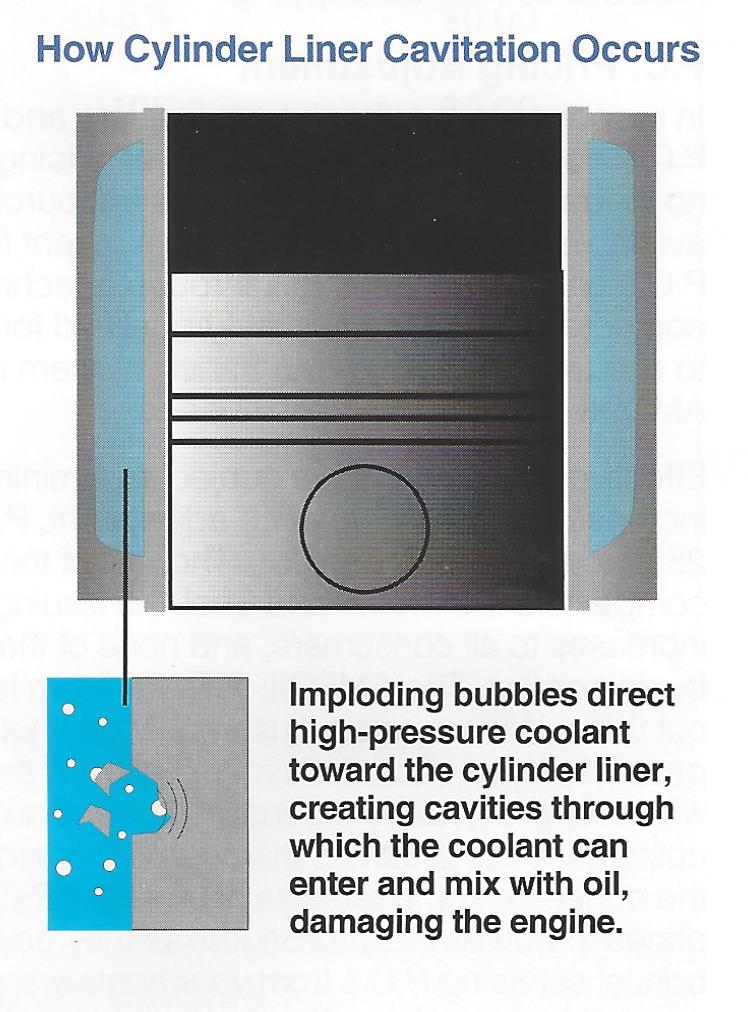Whether They’re In Your Mouth Or Your Engine
Mark Nyholm | TECHNICAL PRODUCT MANAGER, HEAVY DUTY
My wife and I went to the dentist recently. I said to the dentist, “I’m in a hurry, so don’t waste time with gas or Novocaine – just pull the tooth so we can get outta here.”
“I wish all my patients had your bravery and fortitude, Mark,” the dentist replied. “Now, which tooth is it?”
I turned to my wife and said, “Open up and show him the tooth that’s bothering you, dear.”
OK, that really didn’t happen.
But that old joke reminds me of cavities, which in turn reminds me of cavitation, a potentially catastrophic mechanical failure sometimes seen in diesel engines.
Honestly, the cavities that sometimes send you to the dentist are similar to the cylinder liner cavitation that can send your diesel to the shop. Most diesel engines are designed with replaceable cast-iron cylinder liners that are pressed into the engine block. While this doesn’t apply to turbodiesel pickups, it affects heavy-duty over-the-road trucks and other diesels. The piston moves up and down inside the liner, while a jacket of coolant surrounds the outside of the liner to cool the engine.
When the engine is running,
the pistons move vertically inside their liners several thousand times per minute. Meanwhile, the rotary motion of the crankshaft applies a thrust force through the connecting rods to the piston. These contradictory movements cause the pistons to hammer the liners, causing significant vibration, similar to the effect of ringing a bell. This vibration can cause air bubbles to form in the coolant surrounding the liner.

When the bubbles rupture, they direct a high-pressure stream of coolant at the liner. Like a rushing river carving away a canyon wall (or Mountain Dew carving your teeth), the coolant can erode the liner until cavities form. Left unchecked, these cavities can keep growing and eventually penetrate the liner, allowing oil and coolant to mix. Once that happens, it’s only a matter of time before the engine fails.
Prevention is the best practice when it comes to cavities,
whether they’re in your mouth or your engine. That task falls on the engine coolant, and there are two ways formulators typically design engine coolant to fight cavitation.
The old-fashioned way
For years, formulators have added metallic salts, like nitrites and molybdenites, to coolant that attach themselves to the liner and form a sacrificial layer. When the coolant bubbles implode, the metallic salts absorb the pressure and break off from the liner surface rather than the metal itself. Metallic salts naturally deplete over time, meaning motorists must replenish them periodically by adding a supplemental coolant additive (SCA) to the coolant reservoir, typically midway through the service interval. Unfortunately, this is often overlooked.
The better way
The trend in the coolant market – and the strategy we use at AMSOIL, is to eliminate adding an SCA by formulating coolant with organic acid technology (OAT). The chemistry of OAT coolants passivates the liner surface, which coats it in a thin inert layer that provides protection against cavitation and corrosion. Unlike old-fashioned metallic salts, the additives in OAT coolants last much longer, meaning you don’t have to replenish the system with an SCA. Modern OAT coolants also help fight problems associated with old-fashioned “green” coolants, like scaling and additive drop-out (which leads to “slime” in your coolant system) due to incompatibility issues.
Aside from using an OAT coolant, it’s good practice to check your coolant level periodically. Also, make sure to check the pH and glycol levels annually. Glycol is important to the level of freeze protection and the coolant’s boiling point. Over time, the water can evaporate from the system and increase glycol concentration, throwing off the coolant’s balance. Perform fluid analysis once a year for best performance. We offer that service through Oil Analyzers Inc. (www.oaitesting.com). We also offer antifreeze test strips on amsoil.com.
Using AMSOIL Heavy-Duty Antifreeze & Coolant (ANTHD) and taking care of your diesel’s cooling system go a long way toward avoiding the financial pain of fixing an engine ruined by cylinder liner cavitation.
As for your teeth, you’re on your own with that.
SLS Note: AMSOIL prices linked to this site are the current AMSOIL On-Line prices. If you have a business and want product for your vehicles and /or equipment, or if you have a storefront business and would like to offer AMSOIL to your customers, contact us for information on opening an account to receive wholesale pricing.
Besides AMSOIL ANTHD Heavy Duty Antifreeze, AMSOIL also offers the following:
- ANT Low Toxicity Propylene Glycol Antifreeze & Coolant for ALL domestic and import passenger cars and light trucks and many Heavy Duty applications.
- ANTPC is a Ethylene Glycol 50/50 pre-mixed antifreeze for ALL domestic and import passenger cars and light trucks.
- RDCBCN Dominator® Coolant Boost which enhances the heat transfer & corrosion protection characteristics of the cooling system.
- Antifreeze Test Strips which can be used to test ALL coolant colors providing the freezing & boiling points as well as the PH pass/fail level.
From the AMSOIL Preferred Customer Magazine, Spring 2018
